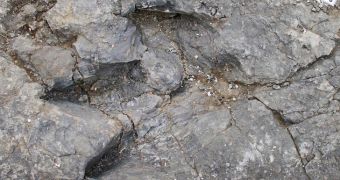Dinosaurs enthusiast Richard McCrea with the Peace Region Palaeontology Center in Canada and fellow researchers claim to have found evidence that tyrannosaurs did not hunt alone, but in packs.
In a study published in the journal PLOS ONE a couple of days ago, the specialists detail the discovery of several footprints left behind by three such ancient beasts in a mud flat located in present-day Canada.
Many other dinosaur footprints have been unearthed over the years. What makes the 70-million-year-old set discovered in Canada stand out is the fact that, by the looks of it, the dinosaurs were walking side by side when they left these tracks.
According to Richard McCrea and colleagues, it is possible that the tyrannosaurs left the footprints while they were busy exploring the area as a group, looking for something to kill and turn into their next meal, Live Science informs.
The researchers detail that the seven tracks believed to have been left behind by ancient beasts that were all members of the same hunting pack were found in an area about 197 feet (60 meters) long and 13 feet (4 meters) wide.
Footprints left behind by several other dinosaurs such as theropods and hadrosaurs were also identified in this region. However, it appears that, when they created their tracks, these other dinosaurs were just aimlessly walking around.
The tyrannosaur footprints, on the other hand, were not only parallel to one another, but also located at about the same depth. This indicates that the beasts that left them behind were moving in the same direction, at the same time. Hence, chances are they formed a pack.
If it is indeed true that these beasts used to hunt as a group, the best explanation for their behavior is that this strategy made it easier for them to bring down large prey. Pack or no pack, specialists say that tyrannosaurs likely behaved aggressively towards one another.
For the time being, specialists cannot say for sure exactly which species created the 70-million-year-old parallel footprints unearthed in Canada. Based on previous studies concerning biodiversity in this part of the world in ancient times, they must have been Albertosaurus, Gorgosaurus or Daspletosaurus.
Interestingly enough, these tracks are not the only evidence that, be it only every once in a while, dinosaurs got together and hunted as a group. Thus, this theory is backed up by the discovery of bones belonging to different animals in the same area in Canada's Dry Island Buffalo Jump Provincial Park.
These bones all belonged to Albertosaurus specimens, and specialists say that, since they were discovered in the same location, it is possible that the animals lived and died as a pack. Then again, it might all be just a coincidence.

 14 DAY TRIAL //
14 DAY TRIAL //